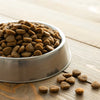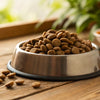Should I Give My Dog Wet and Dry Food? Exploring the Benefits of a Mixed Diet
- Houndsy
Table of Contents
- Introduction
- Understanding Wet and Dry Dog Food
- The Case for Mixing Wet and Dry Dog Food
- How to Mix Wet and Dry Dog Food
- Common Concerns and Considerations
- Conclusion
- FAQ Section
Introduction
Have you ever stood in the pet food aisle, overwhelmed by the sheer variety of options available for your dog? With countless brands and types of food on the shelves, pet owners often find themselves asking, "Should I give my dog wet and dry food?" This question is more than just a dietary choice; it reflects our desire to provide our furry friends with the best nutrition possible while also considering their preferences and health conditions.
In recent years, the conversation around dog food has evolved significantly, emphasizing not just nutritional value but also palatability and convenience. For many pet owners, the dilemma of choosing between wet and dry food can feel daunting. However, understanding the benefits of each type and how they can complement each other can simplify the decision-making process.
In this blog post, we will dive deep into the topic of wet and dry dog food, exploring their nutritional differences, benefits, and how combining them can create a balanced diet for your beloved pet. By the end of this article, you will have a comprehensive understanding of whether you should feed your dog both wet and dry food, and if so, how to do it effectively. So, let’s embark on this journey to enhance our dog’s dining experience together!
Understanding Wet and Dry Dog Food
Before we can answer the central question, it’s essential to understand what wet and dry dog food entails.
What is Wet Dog Food?
Wet dog food, often referred to as canned food, typically contains a high moisture content—generally around 75% to 80%. This type of food is processed by cooking meat and other ingredients under high pressure, which preserves the food and provides a rich flavor that many dogs find irresistible.
Benefits of Wet Dog Food:
- High Moisture Content: Wet food helps keep your dog hydrated, which is especially beneficial for those who might not drink enough water.
- Palatability: The aroma and texture of wet food tend to be more appealing to dogs, making it an excellent choice for picky eaters or those with reduced appetites.
- Easier to Chew: Wet food is typically softer, making it a good option for older dogs or those with dental issues.
What is Dry Dog Food?
Dry dog food, commonly known as kibble, contains significantly less moisture—usually around 10% to 12%. This food is produced through a process of cooking and then extruding the ingredients into the desired kibble shape.
Benefits of Dry Dog Food:
- Dental Health: The crunchy texture of kibble can help reduce plaque and tartar buildup, promoting better dental hygiene.
- Convenience: Dry food is easier to store, measure, and serve, making it a practical choice for busy pet owners.
- Cost-Effective: Generally, dry dog food is less expensive than wet food, which can be beneficial for long-term feeding.
Nutritional Comparison
Both wet and dry dog food can provide complete and balanced nutrition for your dog, but they do have different nutritional profiles. Wet food often contains higher protein levels and fewer carbohydrates, while dry food can be enriched with fiber to support digestive health.
As you consider your dog's specific needs, it’s crucial to consult your veterinarian for tailored recommendations. They can help you understand your dog’s dietary requirements based on their age, size, activity level, and any specific health concerns.
The Case for Mixing Wet and Dry Dog Food
Now that we understand the individual benefits of wet and dry dog food, let’s explore the advantages of mixing the two.
1. Increased Palatability and Variety
Just like humans, dogs enjoy variety in their meals. Mixing wet and dry food can enhance the flavor and texture of their diet, making mealtime more exciting. For picky eaters, the combination may entice them to eat more consistently.
2. Improved Hydration
As mentioned earlier, wet food is beneficial for hydration. By mixing it with dry food, you can ensure that your dog gets a higher moisture intake, especially important for those who may not drink enough water throughout the day. This is particularly beneficial for dogs prone to urinary or kidney issues.
3. Nutritional Balance
A mixed diet can offer a well-rounded nutritional profile. Dry food provides fiber and helps maintain dental health, while wet food offers higher protein content and hydration. Together, they can address various nutritional needs.
4. Weight Management
For dogs that tend to overeat or need to lose weight, mixing wet and dry food can help create a sense of fullness while controlling calorie intake. The higher moisture content in wet food can promote satiety, which is beneficial for dogs on weight management plans.
5. Convenience and Cost-Effectiveness
While wet food can be more expensive, using it as a topper or mixer with dry food can help stretch your budget while still providing the benefits of both types of food. Additionally, dry food’s longer shelf life makes it easier to manage.
How to Mix Wet and Dry Dog Food
If you decide to try a mixed feeding approach, here are some tips to help you get started:
1. Consult Your Veterinarian
Before making any changes to your dog’s diet, it’s essential to consult your veterinarian. They can help you determine the appropriate amounts of wet and dry food based on your dog’s specific dietary needs, age, and activity level.
2. Monitor Portions Carefully
When mixing wet and dry food, it’s vital to keep track of your dog’s overall calorie intake to avoid overfeeding. You may want to calculate the daily caloric requirements for your dog and adjust the portions of each food type accordingly.
3. Start Gradually
If your dog is not used to one type of food, introduce the new diet gradually over several days. Start by mixing a small amount of wet food with their regular kibble, and gradually increase the proportion until you reach your desired mix.
4. Keep It Fresh
Once opened, wet food should be refrigerated and used within a few days to prevent spoilage. Mixing with dry food can also create a mess if left unattended, so serve the mixture promptly and discard any leftovers after a few hours.
5. Experiment with Textures
Dogs can be particular about their food textures. Consider trying different brands or types of wet food to see what your dog enjoys most. You can also adjust the ratio of dry to wet food based on their preferences.
Common Concerns and Considerations
While mixing wet and dry dog food can be beneficial, there are some concerns to keep in mind:
1. Potential Digestive Upset
Some dogs may experience digestive upset when introducing new foods. If you notice any signs of discomfort or abnormal bowel movements, consult your veterinarian.
2. Higher Cost
While mixing can be a cost-effective solution compared to an all-wet food diet, it’s essential to consider your budget. Wet food can be pricier, so balancing your dog’s diet with dry food can help manage costs.
3. Storage and Shelf Life
Wet food has a shorter shelf life once opened compared to dry food. Be sure to store it properly and monitor expiration dates to ensure your dog is eating fresh food.
4. Individual Preferences
Every dog is unique, and what works for one may not work for another. Be attentive to your dog’s preferences and adjust their diet accordingly. Some dogs may prefer one type of food over the other, so finding the right balance is key.
Conclusion
In conclusion, the question of whether to give your dog wet and dry food can be answered with a resounding yes—mixing the two can provide a variety of benefits, including improved hydration, palatability, and nutritional balance. By carefully considering your dog’s individual needs and preferences, you can create a diet that not only satisfies their taste buds but also supports their overall health.
As we strive to simplify and elevate the dog-feeding experience, we invite you to explore innovative solutions that make mealtime enjoyable. Our Houndsy Kibble Dispenser is designed to complement your pet's feeding routine, offering perfect portion control and ergonomic convenience. Discover the Houndsy Kibble Dispenser here!
FAQ Section
1. Can I mix wet and dry dog food every day?
Yes, many pet owners successfully mix wet and dry dog food daily. Just ensure you're monitoring portion sizes to meet your dog’s nutritional needs.
2. How much wet food should I mix with dry food?
The ratio can vary based on your dog’s preferences and dietary needs. A common starting point is to mix 25% wet food with 75% dry food, then adjust based on your dog's response.
3. Is it safe to switch between wet and dry food?
Switching between wet and dry food is safe for most dogs, but it’s best to do so gradually to avoid digestive upset.
4. What should I do if my dog doesn’t like wet food?
If your dog is hesitant to eat wet food, try different brands or flavors. You can also warm it slightly to enhance its aroma, making it more enticing.
5. How can I ensure my dog is hydrated?
Mixing wet food with dry food helps increase hydration. Additionally, always provide fresh water for your dog to drink throughout the day.
By understanding the benefits and considerations of each food type, we can confidently create feeding routines that enhance the health and happiness of our beloved pets. Happy feeding!












